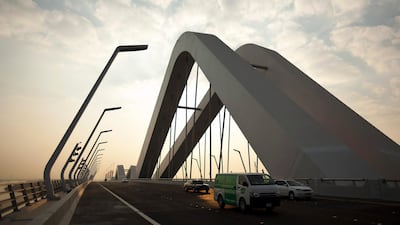A little under five years ago, Abu Dhabi changed the names of a number of its major roads: Al Salam Street became Sheikh Zayed bin Sultan Street, in honour of the Founding Father, and 6th Street or Al Najda Street became Fatima bint Mubarak Street, in recognition of the Mother of the Nation, among others.
The renamings were part of a broader push by Abu Dhabi Municipality to establish a formal citywide street and postal address system and also served another purpose, encouraging residents to be more inquisitive about the country's heritage and those who have shaped its history.
What has happened since the 2013 renamings has made for an interesting and informal social experiment. Many of those who have been in Abu Dhabi for a number of years still use the old names of the city’s main arteries in a daily reminder that old habits often die hard.
Newer arrivals, on the other hand, might look inquisitively at someone who refers to Shakhbout bin Sultan Street by its former name of Al Saada and wonder why they are using what is an apparently wrong title.
Below those two stratas of street naming conventions, there are a number of areas and roads that are still referred to by the labels that were attached to them decades ago: Airport Road, Electra Street and Muroor Road being three of the more prominent examples of this in reference to the first uses of those roads as the destination points for the now executive airport, electrical stores and traffic department compounds respectively.
But there is also something else at work here. The colloquial street names serve as crumbs left behind from previous eras, but what happens when those leftovers are swept away entirely?
For the past 10 years this newspaper has documented the near perpetual state of change in the city, reporting on the construction and commissioning of those key landmarks that now populate our landscape: Louvre Abu Dhabi, Sheikh Zayed Bridge, the Grand Mosque and Yas Island, among many others.
We've also informally documented the more granular nature of change in our timeframe section, a weekly window onto the past, which provides commentary on the buildings or people it features.
Over the years, timeframe has shed light on some lost landmarks, such as the much-loved Volcano Fountain that used to charm and delight visitors to the Corniche. There are many others, such as the original site of what later became the British School Al Khubairat, one of the older schools in the city, or the old Tourist Club itself. Neither the tourist club nor the old school buildings were of particular architectural interest when they made way for new developments – and we shouldn't mourn their loss – but surely there should be a way of documenting their small part and that of other buildings and dwellings in the city's growth from trading post to modern metropolis?
There are already several key landmarks that have been singled out as being of historical significance, such as the central bus station, but what about marking the stories they offer up, such as the original intended use of Al Bateen Mall as a transportation hub rather than as its current arrangement as a well-established neighbourhood shopping centre.
In the UK, under a scheme administered by English Heritage, blue plaques have been put up over the past 150 years honouring notable people associated with a particular building or house. The criteria for inclusion is often as simple as a famous or notable person having lived or worked at the location. One of my favourite examples was unveiled last year in Surrey to honour Ken Wood, the inventor of the Kenwood Chef food mixer and the workshop he used in the 1940s. That building is now used by a tyre replacement company and is of no historical significance save for being a place where Wood spent a lot of time thinking and inventing. The plaque serves as a cue for the curious to investigate further.
The Abu Dhabi equivalent of blue plaques is currently the street naming system administered by the municipality, which helps promote the stories of those who have served the country with distinction. Saif Ghobash Street, for instance, honours the work of the first Minister of State for Foreign Affairs, who was assassinated in 1977.
A member of the FNC told this newspaper at the time of the unveiling of the street name: “Now that a road is named after him, people will want to research and know more about his history.”
Without doubt, many people will have looked up the minister’s years of distinguished service because of the road naming, but an extension of our scheme into information plaques posted next to street signs or on buildings or sites would help foster further and more instant inquiry among both citizens and residents.
They don’t have to be blue plaques, of course. An Abu Dhabi equivalent could be one that uses the colours of the flag.
As The National reported last week, we now know the land outside Abu Dhabi was lush and bountiful 8,000 years ago, which encouraged settlers to set up camp and build sophisticated houses. Wouldn't it be great if we all had even more detail about our living history as well?
Information plaques could be a boon for tourism as well, instantly adding hundreds of sites of interest to the city’s map, which in turn would promote further walking or bus tours. The plaques could easily be linked to an app.
Introducing them would reveal in greater detail the rich and varied tales of the city.
Nick March is assistant editor-in-chief of The National



